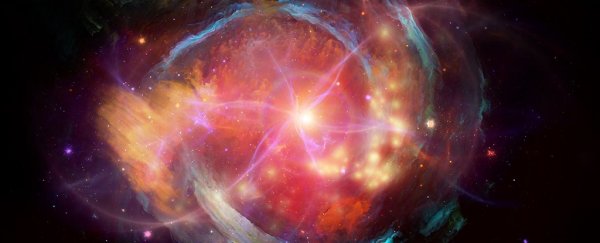Every time tabloids and social media dramatically mishandle a science news story, the urge to unplug the internet and plug it back in again is excruciatingly strong.
If you've heard the recent claim that NASA detected a parallel universe (!) in Antarctica (!) where time runs backwards (!!), we're glad you've now clicked on this article. Strap yourselves in for the truth.
"It seems that for this tabloid science story, some speculative theoretical physics which might have had distant roots in plausibility was amplified for sensational reasons," University of Hawai'i at Mānoa experimental particle physicist Peter Gorham told ScienceAlert.
The egregious 'parallel universe detected' nonsense started out innocently enough.
The respectable New Scientist magazine published a (pay-walled) feature on April 8, discussing some anomalous results coming from neutrino detection experiments in Antarctica, and what these could mean for a speculative cosmological model that posits there's an antimatter universe extending backwards from the BigBang.
Then some online outlets, uh, 'borrowed' this report, the whole thing snowballed, and here we are.
So what's really going on with these anomalous detections in Antarctica? We have reported before that the Antarctic Impulsive Transient Antenna (ANITA) experiment - a high-altitude helium balloon with an array of radio antennas, partially funded by NASA - has spotted a handful of instances of what seem to be highly energetic neutrinos coming through Earth.
Here's why that's super weird. Neutrinos are those 'ghostly' fundamental particles that flow through everything, barely interacting with normal matter, which makes them exceedingly hard to detect. But when produced by powerfully explosive objects in the Universe, neutrinos can gain such ultra-high energies, they become more likely to interact with normal stuff.
ANITA, flying high above the icy continent, is designed to detect signals of secondary particle showers produced as high-energy neutrinos smash into ice. But such neutrinos are supposed to come from the depths of cosmos, not Earth - since chances are good they would have smacked into something else before getting all the way through our planet.
See? Weird. Physicists have been carefully working to figure out if these results can be explained with our current models of physics, or have something to do with the experimental set-up itself, or if something truly wild is going on.
As Gorham, who is the principal investigator of ANITA, told ScienceAlert, "we have encountered a small number of anomalies in our data, and once we have exhausted all of the possible explanations within the Standard Model of physics, only then is it time to consider other ideas that push those boundaries - we are really not there yet, certainly not at the point where parallel universes are necessary!"
Yeah. Couldn't put it any clearer.
The headline-grabbing parallel universe notion is fun, mind-bending stuff to think about on its own. It proposes the existence of an antiuniverse dominated by antimatter, stretching back in time from the Big Bang and with spatial properties inverted to those in our own Universe, obeying the fundamental rule of charge, parity, and time (CPT) symmetry on the grandest scale.
One speculative paper has linked this 'CPT symmetric universe' idea with the anomalous ANITA detections. Sadly, the way it was contextualised in the original pay-walled article has been entirely lost in the many, many iterations of "NASA found a parallel universe" that have spawned over the past couple days.
"In this case, one or more journalists have evidently moved ahead with an article which was not verified, and for reasons which are not clear, have ascribed research and papers to us which we never wrote, and theories, such as those involving parallel universes, which neither we nor our collaborators hypothesised about or discussed in any publication before these results were attributed to our experiment," says Gorham.
"This is one of the reasons that scientific advances proceed by a more measured process, through peer review and verification by other investigators."
Ouch. Let's just all agree to not trust 'science news' from tabloids once and for all. We already had that conversation this week.
